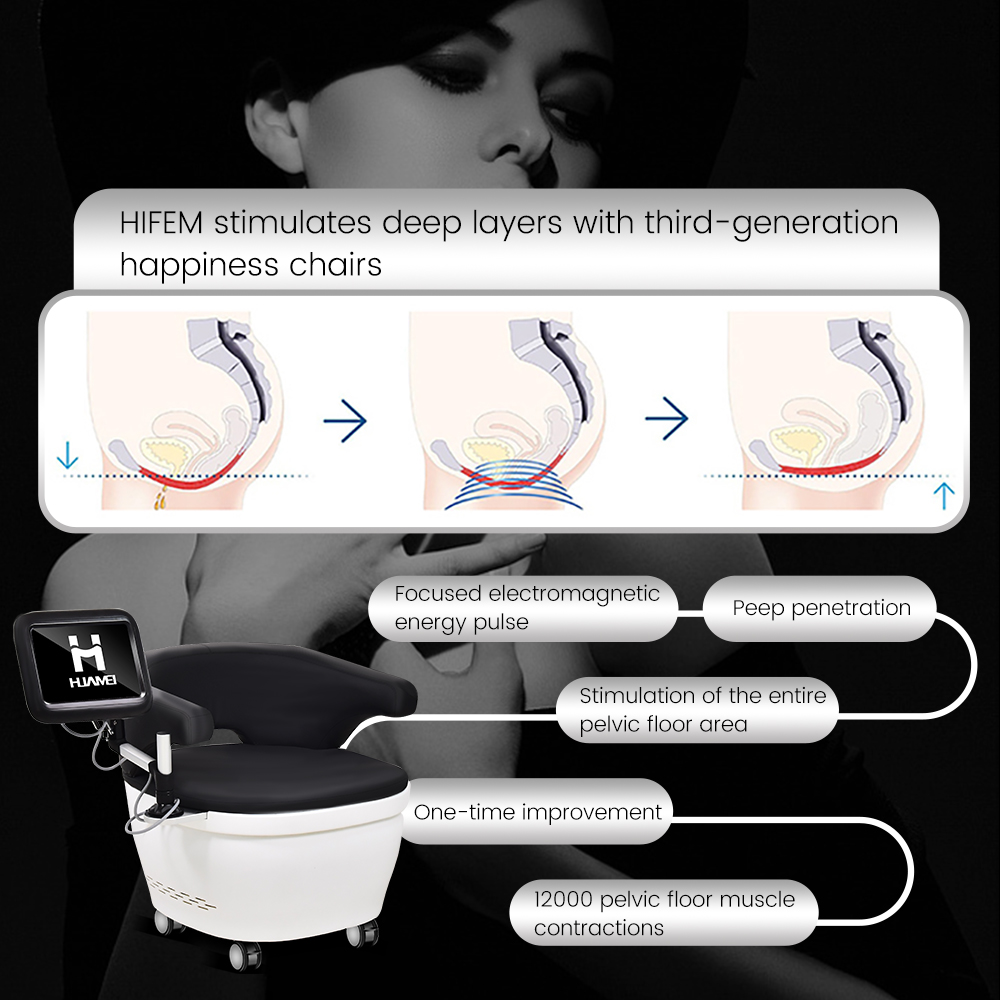The Effectiveness of Slimming Machines: Cryolipolysis, Inner Ball Roller, VelaShape, and Vacuum Technologies
December 29, 2025The Effectiveness of EMS Chair Machine for Strengthening Pelvic Floor and Treating Urinary Incontinence
October 24,2024
The use of EMS (Electrical Muscle Stimulation) chair machines for strengthening pelvic floor muscles and treating urinary incontinence has gained significant attention in recent years. These advanced devices employ electrical currents to stimulate muscle contractions, offering a non-invasive and effective solution to various pelvic floor issues. In this article, we will explore the effectiveness of EMS chair machines for pelvic floor strengthening and urinary incontinence treatment, as well as their underlying mechanisms and potential benefits.
Understanding Pelvic Floor Muscles and Urinary Incontinence
The pelvic floor muscles are a group of muscles, ligaments, and connective tissues that form a sling or hammock at the base of the pelvis. These muscles play a crucial role in supporting the bladder, uterus, and bowel, and are essential for controlling urination and bowel movements, as well as maintaining sexual function. Weakening of these muscles can lead to various issues, including urinary incontinence, pelvic organ prolapse, and sexual dysfunction.
Urinary incontinence, or the inability to control urination, can be caused by various factors, including childbirth, aging, obesity, and chronic conditions such as diabetes and neurological disorders. It significantly impacts the quality of life of those affected, causing embarrassment, discomfort, and limitations in daily activities.
EMS Chair Machine: Mechanism of Action
EMS chair machines work by delivering electrical currents to the pelvic floor muscles, causing them to contract. This stimulation mimics the natural contraction of muscles during exercises such as Kegels, but with a more consistent and controlled application. The high-intensity pulsed electromagnetic technology used in some EMS chairs generates directional motion force, stimulating motor neurons to control the contraction of pelvic floor muscles, activate pelvic floor tissues, and promote collagen regeneration.
One notable advantage of EMS chair machines is their ability to target specific muscle groups with precision. This targeted stimulation ensures that the pelvic floor muscles receive the necessary exercise without putting undue strain on other muscles or joints.

Effectiveness in Strengthening Pelvic Floor Muscles
EMS chair machines have been shown to be effective in strengthening pelvic floor muscles. The electrical currents stimulate muscle contractions that are similar to those achieved through traditional exercises such as Kegels. However, the consistency and controlled application of the stimulation make EMS chairs a more efficient and effective option for many individuals.
Regular use of EMS chair machines can lead to improved muscle tone, strength, and endurance. This, in turn, can help to prevent and manage various pelvic floor issues, including urinary incontinence, pelvic organ prolapse, and sexual dysfunction.
Treatment of Urinary Incontinence
EMS chair machines have also proven to be effective in treating urinary incontinence. By strengthening the pelvic floor muscles, these devices help to improve bladder control and reduce leakage. Studies have shown that EMS therapy can significantly reduce the frequency and severity of urinary incontinence episodes, leading to improved quality of life for those affected.
One study, for example, found that women who underwent EMS therapy for urinary incontinence reported significant improvements in their symptoms, with many achieving complete continence. The study highlighted the effectiveness of EMS therapy in treating both stress and urge incontinence, suggesting that it could be a valuable addition to traditional treatment options.
Additional Benefits of EMS Chair Machines
Beyond strengthening pelvic floor muscles and treating urinary incontinence, EMS chair machines offer several additional benefits. These devices can help to improve sexual function by enhancing blood flow to the pelvic region and stimulating nerve endings. They can also promote skin tightening and firming, addressing issues such as sagging and laxity that may occur with aging or weight changes.
Furthermore, EMS chair machines are generally safe and well-tolerated by most individuals. The non-invasive nature of the therapy means that there is no risk of infection or other complications associated with surgical procedures. However, it is important to consult with a healthcare professional before starting any EMS therapy to ensure that it is appropriate for your specific needs and medical history.

Conclusion
In conclusion, EMS chair machines offer a promising solution for strengthening pelvic floor muscles and treating urinary incontinence. Their ability to deliver targeted muscle stimulation with precision and consistency makes them an effective option for many individuals. Regular use of these devices can lead to improved muscle tone, strength, and endurance, as well as reduced symptoms of urinary incontinence and improved sexual function.
While EMS chair machines are generally safe and well-tolerated, it is important to consult with a healthcare professional before starting any therapy. They can help to determine if EMS therapy is appropriate for your specific needs and provide guidance on how to use the device effectively. With proper guidance and regular use, EMS chair machines can be a valuable tool in maintaining pelvic floor health and improving overall quality of life.